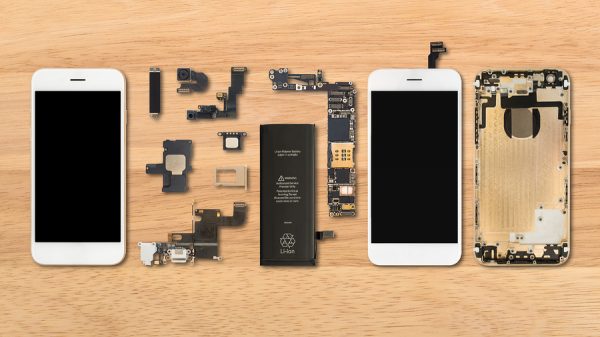
Everyone from smartphone manufacturers to the Environmental Protection Agency (EPA) has encouraged consumers to recycle their cell phones instead of tossing them in the trash. But, many people don’t understand why recycling a cell phone is so important because they don’t know about the materials that are hiding within their devices. Here’s a look at some of the materials that are inside a cell phone—and why it’s so important to recycle them:
LCD Displays
Liquid crystal displays, or LCD displays, contain liquid crystals that are embedded between multiple layers of glass. The liquid crystals often contain toxic chemicals, including mercury, which should not be left in a landfill where they can contaminate the environment. E-waste recyclers can separate the glass from other parts of the cell phone and sell it to manufacturers who can then reuse the glass to create screens on new devices.
Not only does e-waste recycling keep toxic chemicals such as mercury out of landfills, it also reduces overall energy use. According to the U.S. Energy Information Administration, glass manufacturing is one of the most energy-intensive industries. By recycling their devices, consumers can ensure that they are doing their part to reduce the demand for new glass so the manufacturing industry does not consume as much energy.
Circuit Boards
The circuit board is often considered the “brain” of the phone since it is responsible for running all of the other parts of the device. To e-waste recyclers, the circuit boards are seen as one of the most valuable components of the smartphone. Circuit boards consist of computer chips, flash memory and ROM chips, and microprocessors. These different elements of a circuit board are made out of precious metals, including copper, gold, lead, silver, and palladium. These materials are valuable—especially gold—so they can be extracted during the recycling process and resold.
Manufacturers purchase these recycled materials from e-waste recyclers so they can use them to create new devices. Manufacturers outside of the electronics industry also purchase these recycled materials to create other products such as jewelry. As a result, manufacturers don’t have to mine the Earth for new materials. To illustrate how important it is to recycle these materials, consider the fact that mining one ounce of gold from the Earth generates around 79 tons of toxic waste. If more people recycled cell phones, manufacturers could rely on recycled materials instead of having to mine for new ones, so they won’t produce nearly as much toxic waste.
It’s estimated that about 100 million cell phones are disposed of every year. If even one million of these cell phones were recycled instead of sent to landfills, manufacturers would be able to recover 75 lbs. of gold, 33 lbs. of palladium, 772 lbs. of silver, and over 35,000 lbs. of copper.
Rechargeable Batteries
Rechargeable batteries, unlike single-use batteries, contain heavy metal elements that are hazardous to the environment, which is one of the many reasons why cell phones should be recycled instead of thrown away. Lithium is the main material that is used to create rechargeable batteries, and it is also one of the most toxic. If a cell phone is sent to a landfill instead of recycled, the lithium from the rechargeable batteries could slowly start to seep into the groundwater, where it will affect the local drinking water supply. Lithium has been linked to birth defects and is also connected to heart, brain, kidney, liver, lung, spleen, and skeletal system damage. Consuming this material can be incredibly dangerous, which is why cell phones need to stay out of landfills.
E-waste recyclers keep lithium batteries out of landfills by reselling this material to manufacturers, who can then reuse it to produce new devices.
Plastics
Plastic is one material that can be found in various places within the smartphone. Plastic is not biodegradable, which means it will break down into smaller and smaller pieces, but never goes away completely. Many microplastics, which are small pieces of plastic, end up in the ocean or environment, where they are consumed by animals. Eventually, these microplastics can end up in your system as they are transferred from animal to animal on the food chain.
When this material is left in landfills, the toxic chemicals that is used to create plastic will slowly start to seep out into nearby groundwater. These toxic chemicals are linked to birth defects, endocrine disruption, and cancers, so people who get their drinking water from the groundwater can suffer greatly.
Do your part to keep plastics out of landfills and the environment by recycling cell phones instead of throwing them in the trash. E-waste recyclers will separate the plastic in your device and pass this material along to manufacturers that can use it to create new products. In addition to creating new smartphones, recycled plastic can also be used to produce furniture, packaging, and other plastic products.
Chargers
A charger isn’t exactly a part of a cell phone, but it is a cell phone accessory that everyone must have in order to use their device. Chargers are made up of a number of different materials, but they mainly consist of copper, plastic, and gold. All of these materials can be reused by manufacturers, so be sure to bring smartphone chargers to e-waste recyclers when you drop off cell phones.
Now that you know all of the materials that are hiding within your cell phone, you probably have a better understanding of why it’s important to recycle these devices. As the largest recycler of electronic devices in the world, we are trusted with the e-waste produced by many Fortune 500 companies. For more information on recycling your electronics, or to request a quote for your company, contact us today.